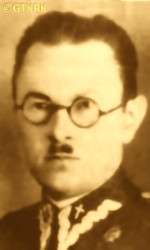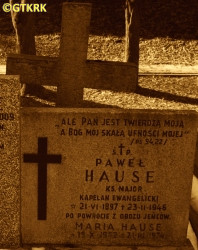Roman Catholic
St Sigismund parish
05-507 Słomczyn
85 Wiślana Str.
Konstancin deanery
Warsaw archdiocese, Poland
full list:
displayClick to display full list

searchClick to search full list by categories
wyświetlKliknij by wyświetlić pełną listę po polsku

szukajKliknij by przeszukać listę wg kategorii po polsku

Martyrology of the clergy — Poland
XX century (1914 – 1989)
personal data
surname
HAUSE
forename(s)
Paul Henry (pl. Paweł Henryk)
function
pastor
creed
Evangelical Church of the Augsburg Confession in Poland EA
diocese / province
Warsaw seniority (commissariat) / diocesemore on
en.wikipedia.org
[access: 2019.04.16]
Evangelical Military Pastoral Caremore on
pl.wikipedia.org
[access: 2024.12.13]
honorary titles
Ten Years of Independence Medalmore on
pl.wikipedia.org
[access: 2019.10.13]
date and place
of death
23.02.1946

Warsawtoday: Warsaw city pov., Masovia voiv., Poland
more on
en.wikipedia.org
[access: 2021.10.09]
details of death
Participant of Polish–Russian war of 1919‐1921.
Served as a soldier of the 2nd Legions Division fighting on the Lithuanian–Belarusian front, then in the Division's HQ in Kielce — reached the rank of sergeant of the 4th Legions Infantry Regiment.
Commissioned chaplain of the Polish army from 01.03.1927.
After German and Russian invasion of Poland in 09.1939 and start of the World War II crossed over the Polish–Romanian border, together with his military unit.
There interned and subsequently handed over to the Germans.
Held in VI E Oflag in Dorsten, II A Stalag in Neubrandenburg, twice — as a punishment — in X C Oflag in Lubeka, and II D Oflag in Gross‐Born–Rederitz.
There prob. overtaken and liberated in 02.19454 by Polish troops fighting alongside Russian army — during East Pomeranian Offensive.
After end of military hostilities of the World War II, after return to Poland in 1945, as a result of camp experiences and untreated cancer, did not recover and perished in military hospital.
cause of death
exhaustion
perpetrators
Germans
sites and events
Ribbentrop‐MolotovClick to display the description, Polish‐Russian war of 1919‐1921Click to display the description
date and place
of birth
21.06.1897

Lipówiectoday: Ojrzeń gm., Ciechanów pov., Masovia voiv., Poland
more on
en.wikipedia.org
[access: 2023.03.24]
presbyter (holy orders)
ordination
18.10.1925

positions held
1945 – 1946
administrator — Nowy Sącztoday: Nowy Sącz pov., Lesser Poland voiv., Poland
more on
en.wikipedia.org
[access: 2021.04.01] ⋄ EA parish
1933 – 1939
EA senior military chaplain — Brest on Bugform.: Brest‐Litovsk /till 1923/
today: Brest, Brest dist., Brest reg., Belarus
more on
en.wikipedia.org
[access: 2021.09.29] ⋄ Evangelical–Augsburg chaplaincy, Corps District OK No. IX Brest on Bug, Polish Armed Forces — de facto head of the chaplaincy
04.02.1934
EA senior military chaplain — Polish Armed Forces — promotion: by order of the President of the Republic of Poland of 04.02.1934, with seniority from 01.01.1934 and 1st place among the military Evangelical clergy, in the rank of major
1927 – 1933
EA military chaplain — Przemyśltoday: Przemyśl city pov., Subcarpathia voiv., Poland
more on
en.wikipedia.org
[access: 2021.04.01] ⋄ Evangelical–Augsburg chaplaincy, Command of the Corps District DOK No. X Przemyśl, Polish Armed Forces — de facto head of the chaplaincy
priest — Nowy Sącztoday: Nowy Sącz pov., Lesser Poland voiv., Poland
more on
en.wikipedia.org
[access: 2021.04.01] ⋄ EA parish
1925 – 1927
vicar — Warsawtoday: Warsaw city pov., Masovia voiv., Poland
more on
en.wikipedia.org
[access: 2021.10.09] ⋄ Holy Trinity EA parish
1925
vicar — Krakówtoday: Kraków city pov., Lesser Poland voiv., Poland
more on
en.wikipedia.org
[access: 2021.06.07] ⋄ EA parish
1922 – 1925
student — Warsawtoday: Warsaw city pov., Masovia voiv., Poland
more on
en.wikipedia.org
[access: 2021.10.09] ⋄ Evangelical Theology Department, University of Warsaw [i.e. University of Warsaw (from 1945) / clandestine University (1939‐1945) / Joseph Piłsudski University (1935‐1939) / University of Warsaw (1915‐1935) / Imperial University of Warsaw (1870‐1915)]
married — two children
others related
in death
BANSZELClick to display biography Charles, BIELIŃSKIClick to display biography Joseph, BURSCHEClick to display biography Edmund, BURSCHEClick to display biography Julius, FALZMANNClick to display biography Alexander Charles, FREYDEClick to display biography Alfred, GNIDAClick to display biography Francis, GUMPERTClick to display biography Steven Edward, GUTKNECHTClick to display biography Bruno, GUTSCHClick to display biography Sigismund, KAHANEClick to display biography George, KOŻUSZNIKClick to display biography Stanislav, KULISZClick to display biography Charles, KUŹWAClick to display biography Sigismund, LEHMANNClick to display biography George, MAYClick to display biography Leo Witold, MAMICAClick to display biography Joseph, MANITIUSClick to display biography Gustav, NIEROSTEKClick to display biography Joseph, NITSCHMANNClick to display biography Adam Robert, OŻANAClick to display biography Gustav, PASZKOClick to display biography Richard, PAWLASClick to display biography Vladislav, WAGNERClick to display biography Richard Ernest, ZMEŁTYClick to display biography Adolph
sites and events
descriptions
Ribbentrop‐Molotov: Genocidal Russian‐German alliance pact between Russian leader Joseph Stalin and German leader Adolf Hitler signed on 23.08.1939 in Moscow by respective foreign ministers, Mr. Vyacheslav Molotov for Russia and Joachim von Ribbentrop for Germany. The pact sanctioned and was the direct cause of joint Russian and German invasion of Poland and the outbreak of the World War II in 09.1939. In a political sense, the pact was an attempt to restore the status quo ante before 1914, with one exception, namely the „commercial” exchange of the so‐called „Kingdom of Poland”, which in 1914 was part of the Russian Empire, fore Eastern Galicia (today's western Ukraine), in 1914 belonging to the Austro‐Hungarian Empire. Galicia, including Lviv, was to be taken over by the Russians, the „Kingdom of Poland” — under the name of the General Governorate — Germany. The resultant „war was one of the greatest calamities and dramas of humanity in history, for two atheistic and anti‐Christian ideologies — national and international socialism — rejected God and His fifth Decalogue commandment: Thou shall not kill!” (Abp Stanislav Gądecki, 01.09.2019). The decisions taken — backed up by the betrayal of the formal allies of Poland, France and Germany, which on 12.09.1939, at a joint conference in Abbeville, decided not to provide aid to attacked Poland and not to take military action against Germany (a clear breach of treaty obligations with Poland) — were on 28.09.1939 slightly altered and made more precise when a treaty on „German‐Russian boundaries and friendship” was agreed by the same murderous signatories. One of its findings was establishment of spheres of influence in Central and Eastern Europe and in consequence IV partition of Poland. In one of its secret annexes agreed, that: „the Signatories will not tolerate on its respective territories any Polish propaganda that affects the territory of the other Side. On their respective territories they will suppress all such propaganda and inform each other of the measures taken to accomplish it”. The agreements resulted in a series of meeting between two genocidal organization representing both sides — German Gestapo and Russian NKVD when coordination of efforts to exterminate Polish intelligentsia and Polish leading classes (in Germany called «Intelligenzaktion», in Russia took the form of Katyń massacres) where discussed. Resulted in deaths of hundreds of thousands of Polish intelligentsia, including thousands of priests presented here, and tens of millions of ordinary people,. The results of this Russian‐German pact lasted till 1989 and are still in evidence even today. (more on: en.wikipedia.orgClick to attempt to display webpage
[access: 2015.09.30])
Polish‐Russian war of 1919‐1921: War for independence of Poland and its borders. Poland regained independence in 1918 but had to fight for its borders with former imperial powers, in particular Russia. Russia planned to incite Bolshevik‐like revolutions in the Western Europe and thus invaded Poland. Russian invaders were defeated in 08.1920 in a battle called Warsaw battle („Vistula river miracle”, one of the 10 most important battles in history, according to some historians). Thanks to this victory Poland recaptured part of the lands lost during partitions of Poland in XVIII century, and Europe was saved from the genocidal Communism. (more on: en.wikipedia.orgClick to attempt to display webpage
[access: 2014.12.20])
sources
personal:
old.luteranie.plClick to attempt to display webpage
[access: 2012.11.23], docplayer.plClick to attempt to display webpage
[access: 2023.03.24], www.konfesyjni.plClick to attempt to display webpage
[access: 2023.03.24]
original images:
docplayer.plClick to attempt to display webpage
[access: 2023.03.24], docplayer.plClick to attempt to display webpage
[access: 2023.03.24], docplayer.plClick to attempt to display webpage
[access: 2023.03.24], pl.wikipedia.orgClick to attempt to display webpage
[access: 2019.04.16]
LETTER to CUSTODIAN/ADMINISTRATOR
If you have an Email client on your communicator/computer — such as Mozilla Thunderbird, Windows Mail or Microsoft Outlook, described at WikipediaPatrz:
en.wikipedia.org, among others — try the link below, please:
LETTER to CUSTODIAN/ADMINISTRATORClick and try to call your own Email client
If however you do not run such a client or the above link is not active please send an email to the Custodian/Administrator using your account — in your customary email/correspondence engine — at the following address:

giving the following as the subject:
MARTYROLOGY: HAUSE Paul Henry
To return to the biography press below:
 Click to return to biography
Click to return to biography











